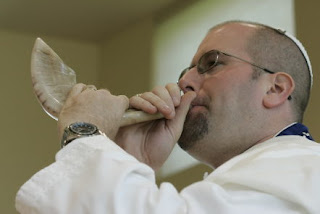The Jewish New Year celebration, Rosh Hashanah (Hebrew, meaning “the head of the year”) begins this week on Wednesday evening and lasts until Friday. Here are five things that everyone should know about the holiday.
 |
| Rabbi Jason Miller blows the shofar (ram’s horn) which is used on Rosh Hashanah |
Popularity
On the Jewish calendar, this holiday is one of the big ones. Even members of the Jewish faith who aren’t regular synagogue attendees make a point of attending services on Rosh Hashana and Yom Kippur, the Day of Atonement, which occurs 10 days later. You’ll notice local synagogue parking lots are overflowing on these days. For some, Rosh Hashanah services are an opportunity for spiritual renewal and introspection. For others, this is a time to visit with friends and enjoy time with family
Significance
The holiday celebrates the beginning of the Jewish calendar, but it is also a period of repentance. Beginning a month prior to Rosh Hashanah, Jewish people make an effort to offer forgiveness for their sins. Prayer, charitable giving, and repentance are the three ways to be written in the metaphorical book of life by God for another year. In addition to the beginning of the Jewish calendar, Rosh Hashanah is a commemoration of the creation of the world, according to the Torah – the Jewish Bible.
Shofar
Perhaps the most common symbol of Rosh Hashanah is the ram’s horn that is blown in the synagogue. With 100 blasts, the shofar is considered a “wake-up call” to remind the Jewish people about the key task at hand — repentance.
Food
Families gather around the table for large celebratory meals on Rosh Hashanah. Traditional Jewish staples such as matzah ball soup, gefilte fish and brisket can often be found on the dinner tables (especially in homes with Eastern European lineage). There are many foods traditionally eaten on Rosh Hashanah to symbolize the holiday’s many themes. Round challah (egg bread) is to signify continuity. Apples are dipped in honey as a blessing for a sweet new year. There is a custom to have a new and different fruit on the table as well.
Observance
Just as with any faith tradition there are different levels of observance among the adherents. Orthodox and Conservative Jews will observe two days of the holiday, while most Reform Jews will only observe one. Many public schools in the area are closed for at least the first day of the holiday. Some Jewish people will abstain from driving on the holiday and will walk to and from the synagogue instead. Adults will stay home from work and many students will miss school if it is in session.
This article originally ran on the West Bloomfield Patch on Sept. 28, 2011.